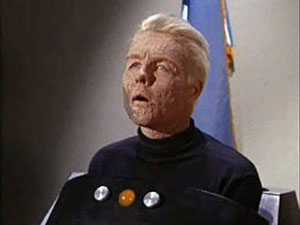 The only two-part episode in the entire series, “The Menagerie” is easily one of the most memorable. It recycles the previously unaired pilot episode into a framing story that adds significant new elements and drama to the events in a masterful piece of seamless writing. This really is an impressive piece of television.
The only two-part episode in the entire series, “The Menagerie” is easily one of the most memorable. It recycles the previously unaired pilot episode into a framing story that adds significant new elements and drama to the events in a masterful piece of seamless writing. This really is an impressive piece of television.
We start at Starbase 11, to which the Enterprise has been called by an urgent signal. The starbase is represented by a matte painting, which looks amateurish compared to the brilliant one for Delta Vega from “Where No Man Has Gone Before”. When we get inside the base buildings, we are treated to a view out the windows which looks like a cardboard cutout of the Seattle Space Needle. But these oddities are quickly pushed aside by the dramatic reveal of Captain Christopher Pike, the previous commander of the Enterprise. Although he says nothing, he is easily one of the most memorable guest characters of the series, as he appears scarred and confined to a wheelchair, unable to move or do anything but communicate “yes” or “no” by causing lights to flash with his brainwaves.
While this is a brilliant piece of drama, it’s a bit difficult to justify, especially these days when we are building technology now that allows people to control computers to do arbitrary commands with nothing but brainwaves. Even if you can’t do that and are restricted to flashing a light, you can still use Morse code or something to communicate more than just “yes” or “no”.
That niggle aside, the drama really ramps up rapidly, as we learn that Spock has lied about receiving the message and starts acting shiftily. He heads to the starbase computer room, where he uses a couple of nerve pinches to deal with the computer technicians. The mainframe computers are covered in kitschy blinking lights, and Spock uses them to spoof a message from Kirk to the Enterprise to prepare for a top secret mission. Taking the message is a Lieutenant Hansen, who is apparently in charge of the Enterprise while Kirk and Spock are away. This anonymous crew member who we’ve never seen before is third in command?
Spock’s behaviour is increasingly bizarre, highlighted by him talking to his old captain, Pike, and saying, “I must, I have no choice.” Knowing what Spock’s about to do, I wonder if he really has no choice… surely there are some options. Anyway, Spock takes Pike back to the Enterprise and warps out of orbit, leaving Kirk behind. Dumbfounded and disbelieving, Kirk gives chase in a starbase shuttlecraft – the first time we see a shuttlecraft in the series. Although this is kind of odd; one would imagine a large starbase would have some sort of longer range vessel available at all times.
The Enterprise picks up the shuttle after it runs out of fuel, because Spock refuses to abandon Kirk to drift in space. Spock then gives himself up for court martial on the charge of mutiny. We’re halfway through Part I by now, and if you haven’t seen this episode before it’s impossible to fathom Spock’s motives. The mystery makes it highly intriguing and compelling.
During the court martial proceedings, Spock plays footage from an earlier mission, when he served under Captain Pike. This is the footage from the pilot episode “The Cage”, and we see almost all of it during the court hearing over both parts of this episode. In itself, “The Cage” makes for compelling viewing – it really was a pretty good pilot. Dosed out here as a flashback, with breaks in which Spock and Kirk exchange tension-building dialogue, it works even better.
Some odd things to note about the “Cage” footage: Captain Pike is seen using a bog-standard clipboard, not the (retro-)futuristic electronic clipboard thingies that Kirk uses. In one scene when Pike is walking through the corridors of the ship, we see a pair of other crew members in mufti, the male wearing shorts and the female in a short cheerleader-style skirt, both looking not much older than teenagers – it’s really weird. When the crew land on Talos IV (the same planet Spock is apparently trying to take the crippled Pike back to), the native scenery includes mysterious humming plants, which are rather funky in a 1960s furniture kind of way.
To cut a long story short, The earlier Pike is captured by the Talosians, who are giant-brained telepaths who want to mate Pike with a female they captured years ago to breed a colony of humans for them to run experiments on. Naturally Pike gets rescued, but the cute female turns out to be horribly deformed and only cute in the telepathically induced dream world. The Talosians turn out to be somewhat contrite, apologising because they didn’t realise humans would object so strongly to being treated as captive experimental subjects(!).
I won’t detail the ending, but suffice to say that Spock’s mysterious actions are explained and, naturally, he isn’t found guilty at the court martial. The story wraps up rather neatly and is overall one of the stand-out episodes of the series. Even though it’s twice as long, it didn’t feel like it watching it in one sitting. (I’m actually fearing some of the poorer episodes to come, as they will no doubt feel longer than this one.)
Body count: None.
Tropes: Clip Show, Once For Yes, Twice For No, Technology Marches On, We Will Use Micros In The Future, Conflicting Loyalty, Screw The Rules, I’m Doing What’s Right, Framing Device, Flashback, My Brain Is Big, Telepathy, Adam And Eve Plot, People Zoo, Throwing Your Sword Always Works, Green Skinned Space Babe (the trope namer!), Dying Race
(Image © 1966 Paramount Studios, used under Fair Use.)



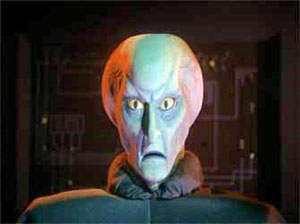 Before launching into this one, I had to decide whether to change the spelling to Australian English, or use the original American spelling of this episode title: “
Before launching into this one, I had to decide whether to change the spelling to Australian English, or use the original American spelling of this episode title: “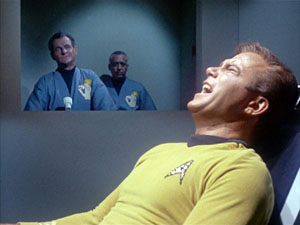 This is the first episode for which I couldn’t recall anything about it from the title, before watching it again. So I figured “
This is the first episode for which I couldn’t recall anything about it from the title, before watching it again. So I figured “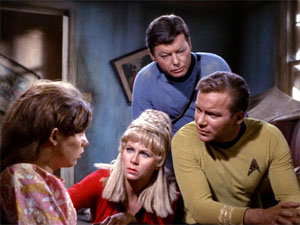 I wasn’t looking forward to
I wasn’t looking forward to 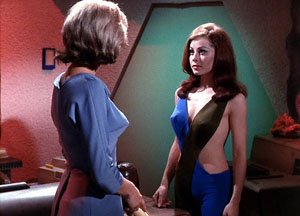 Nurse Christine Chapel plays a big role in
Nurse Christine Chapel plays a big role in 
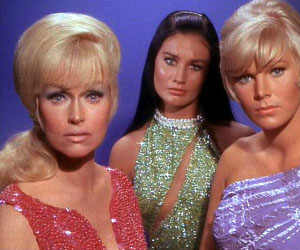 Wow, I’m ripping through these episodes! I don’t normally watch DVDs this frequently, but I feel like I’m getting on a bit of a roll. Anyway, on to “
Wow, I’m ripping through these episodes! I don’t normally watch DVDs this frequently, but I feel like I’m getting on a bit of a roll. Anyway, on to “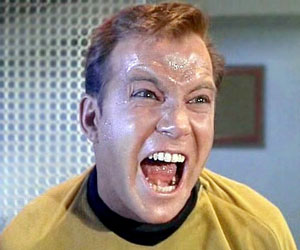 Ah, the transporter accident. Transporters were one of the great plot devices that Star Trek gave to television. This episode begins with one of the myriad possible forms of transporter failure, and a particularly odd one. Rather than simply killing Kirk or scattering his component molecules to all corners of the galaxy, it splits him into two halves – a “good” half and and “evil” half.
Ah, the transporter accident. Transporters were one of the great plot devices that Star Trek gave to television. This episode begins with one of the myriad possible forms of transporter failure, and a particularly odd one. Rather than simply killing Kirk or scattering his component molecules to all corners of the galaxy, it splits him into two halves – a “good” half and and “evil” half.